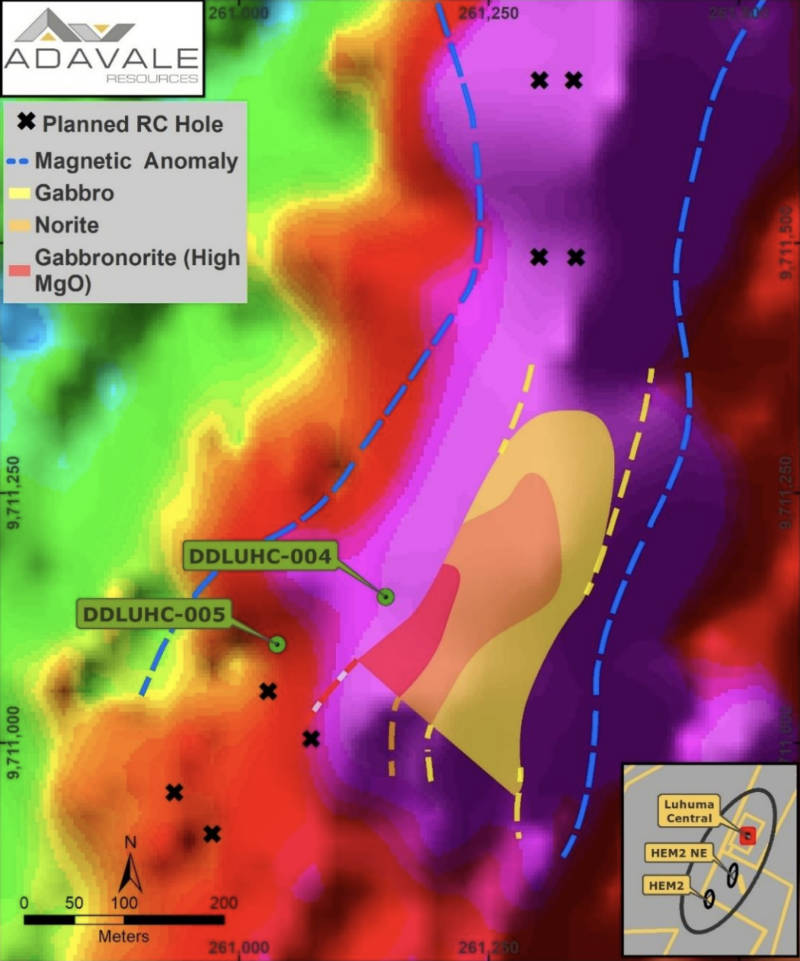Finding the Feeder Zone: Adavale could be getting close to another Kabanga discovery at Luhuma Central

Adavale’s exploration has pointed to the untested southern end of Luhuma Central as being the most prospective for nickel sulphide mineralisation. Pic: Klaus Vedfelt via Getty Images.
- Adavale drilling hits higher levels of magnesium (MgO), which points to high nickel sulphide accumulations, at Luhuma Central
- New holes also had higher nickel tenor in massive nickel sulphide intercepts than holes to the north
- Results indicate that open untested southern end of Luhuma Central is the most prospective part of the intrusion
- RC drilling continuing with more results expected in early November
Adavale continues to narrow in on prize at the Luhuma Central prospect after its two most recent diamond drillholes intersect significantly higher levels of magnesium (MgO) – a known vector to high nickel sulphide accumulations.
Adavale Resource’s (ASX:ADD) Kabanga Jirani and the farm-in ‘Luhuma’ licences are adjacent to and along strike from the Tier 1, high-grade Kabanga project, one of the world’s largest undeveloped nickel deposits with a 58Mt resource grading 2.62%.
Neighbouring such a rich deposit — which is being developed as a 30-year, 65,000tpa nickel equivalent operation — frames Adavale’s exploration success to date in a positive light and providing a hint of the scale that it is chasing.
Adavale started diamond drilling at Luhuma Central in late May as part of a broader 5,000m combined diamond drilling and reverse circulation drill program to test a series of targets generated by the company around the Luhuma Trend.
The Luhuma Trend – which includes Central, HEM 2, HEM 2NE and HEM 2E — is a narrow 15km long belt within its Kabanga Jirani project that is characterised by strongly elevated gravity and electromagnetic anomalism.
Vector to favourable ultramafic geology
Laboratory assays confirmed that every one of the company’s first five diamond holes had intersected significant massive and/or semi-massive sulphide mineralisation with a top intercept of 7.55m at 0.96% nickel, 0.12% copper and 0.18% cobalt.
But it gets better – results from the two most recent drillholes indicate the company is getting close to the motherlode, with a significant increase in MgO a vector “for more primitive, hence favourable ultramafic geology”.
Holes DDLUHC004 and DDLUHC005 returned between 10% and 17% MgO, higher than the 4% to 7% seen in the three previous holes to the north.
This geology is feature of large nickel sulphide deposits, Adavale says.
Lending credence to this, the company noted that the massive sulphide intersected in DDLUHC004 returned 1.34% nickel, which is slightly higher grade than the approximately 1% nickel seen in the northern holes.
At DDLUHC005, the nickel tenor of the broad zone of 3-7% disseminated sulphides intersected in the hole appear to be broadly in keeping with the massive sulphides intersected in DDLUHC004 to the north.
This hole also intersected a thin massive sulphide zone of 0.3m grading 1.26% nickel from a down-hole depth of 423.4m – another indicator that the nickel tenor increases towards the south.
Combining the potential increase in nickel tenor to the south with the similar, more primitive nature of their associated host rocks indicates that open untested southern end is the most prospective part of the intrusion.
Adding further interest, strong conductive responses generated by the orientation ground electromagnetic survey underway at Luhuma Central correlate strongly with down-hole EM plates modelled around the recent massive sulphide intersections.
Ground EM is expected to enable the company to trace the continuity of nickel mineralisation using a lower density of drillholes.

“Finding the high MgO ultramafic ‘feeder zone’ to a magmatic nickel sulphide rich intrusive system in the East African Nickel Belt has been one of our preliminary goals,” executive director David Riekie said.
“We are very pleased to have identified vectors at Luhuma Central that point us towards these prospective zones. This is an excellent outcome from this round of drilling so far.
“In addition, the strong correlation between the orientation ground EM survey data and modelled DHEM plates at Luhuma Central means we can now confidently extend the ground survey to trace prospective massive nickel sulphide mineralisation, both north and south and test potential strike extensions.”
Further activity
Adavale is continuing reverse circulation drilling at HEM 4 to determine if a series of coincident EM, geochemical and gravity anomalies identified there are associated with favourable host rocks at depth below the cover sequence.
Results from this program are expected in early November.
The company is also awaiting results from the ground EM survey, and RC drilling at Luhuma Central.
This article was developed in collaboration with Adavale Resources, a Stockhead advertiser at the time of publishing.
This article does not constitute financial product advice. You should consider obtaining independent advice before making any financial decisions.
Related Topics
UNLOCK INSIGHTS
Discover the untold stories of emerging ASX stocks.
Daily news and expert analysis, it's free to subscribe.
By proceeding, you confirm you understand that we handle personal information in accordance with our Privacy Policy.








